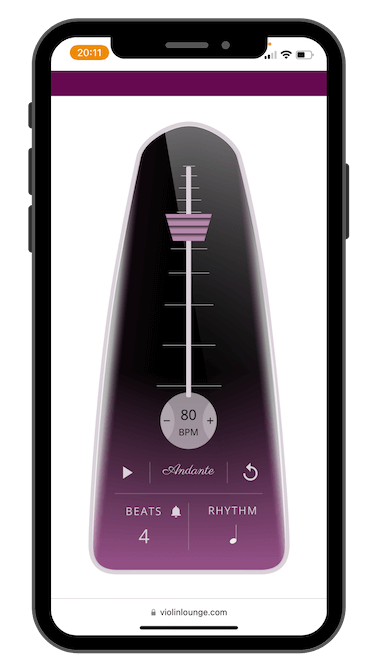How to practice violin with a metronome | Violin Lounge TV #520
Practice tips to learn difficult rhythms and tackle fast runs on the violin
Practice along with me with different pieces, so you’ll learn to practice effectively with the help of a metronome.
Tackle fast runs on the violin
But I just can’t play any faster! What do I do?
First, recognize that gradually increasing your speed takes time. Depending on the difficulty of the piece, give it at least a few months before declaring that you’ve reached a plateau.
If you really can’t go any faster, increase the speed by 10-20 BPM. I know it sounds crazy, but stay with me for a second. Play the section a few times at this new faster speed. It doesn’t have to be perfect but aim to get through it. Then increase the speed again and repeat the process. Now, go back to the original, desired speed. It should seem much slower and more manageable.
Rhythmical Variations
The best way to increase your speed in runs is to practice rhythmical variations. The aim of this practice technique is to practice just a few notes at a time, but at a very quick speed, which will increase the overall speed at which you’re able to play the run. Here are the steps to follow to practice in rhythmical variations:
- Play two notes as fast as possible. Take out all bowings and play each note separately.
- Stop for as long as necessary to mentally prepare for the next two notes.
- Repeat for the remaining length of the run.
- Now, practice in opposite pairs. To do this, start out with a single note, and then resume playing in pairs. You should be playing different pairs than before.
- Repeat the process with groups of three, four, six, and eight.

Hi! I'm Zlata
Classical violinist helping you overcome technical struggles and play with feeling by improving your bow technique.
Difficult rhythms to practice with a metronome
Dotted rhythms (dotted quarters, dotted eighths followed by sixteenths, etc)
These rhythms are challenging because you have to play off of the beat (meaning that you are not going to be playing right with the click of the metronome.) However, when practicing along with this online metronome, you can simply choose these rhythms in the bottom right-hand corner and play exactly with the beats.
Triplets (especially when in combinations of eighths and quarters)
The most common tendency when practicing triplets is to rush. I like to call triplets “the lazy rhythm” to help remind students to evenly spread the three notes out over the beat. When faced with triplets in combinations of eighths and quarters, I recommend subdividing the triplet in your head.
Syncopated rhythms
Syncopations are difficult because you have to play off of the beat of the metronome (similar to dotted rhythms). Along with subdividing and using the built-in syncopation rhythms in this online metronome, I recommend listening to the piece as much as possible to internalize the rhythm.
This might be helpful too:
My article on how to read rhythms and note values in sheet music
My article on how to practice with a metronome as a beginner violinist


Isn’t the first thing to nail down to be the best fingering? What about string crossings and spicatto?
Yes, definitely. And you can certainly practice bowing techniques with the metronome too. I’ve got a lot of videos on this website about bowing.